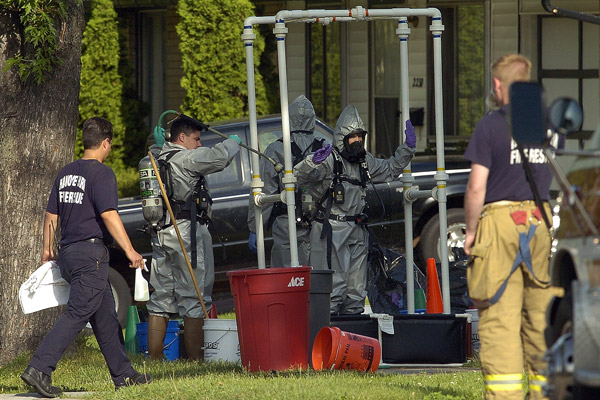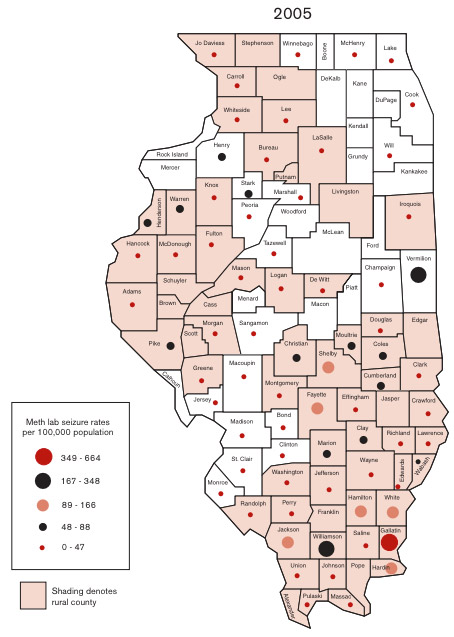
While I was aware that meth production was a problem in Appalachia and the southern Midwest, I tended to assume that it was still more of a western problem. So this, via John Darnielle's* tumblr, came as a surprise:

Illinois ranks fairly high in terms of meth lab incidents. But it borders on, or is within a short drive of, the biggest meth-producing states in America by far. Looking back at NSS data, the number of incidents has declined precipitously on the west coast, but remained relatively steady in the southern Midwest.
In 2004, Dr. Ralph Weisheit of ISU did an ethnography of meth in downstate Illinois (PDF), specifically in Edgar and Clark counties—two east central counties that are better off than some of their downstate neighbors, with reasonably low unemployment and poverty rates. Around that time there wasn't much in the way of meth lab seizures there, but neighboring counties were struggling with it (PDF):

What's interesting about Weisheit's findings is that the market there wasn't particularly formal; rather than a robust drug trade, it was more of a barter economy of petty crime:
Reports from a variety of local sources suggest there is little in the way of a “methamphetamine business” in either county, at least not a highly organized business driven by cash transactions. Rather, methamphetamine production and use appear to primarily rely on bartering and trading services for drugs among acquaintances. For example, a cook will agree to provide methamphetamine to several associates in exchange for each associate stealing or otherwise obtaining necessary precursors (e.g., anhydrous ammonia, cold pills, lithium batteries, lantern fuel). In other cases the cook may agree to teach others to cook in exchange for them each providing the precursors needed to conduct the “class,” with a share of the drugs serving as the cook’s payment. The absence of a cash economy in methamphetamine, or at least the presence of a very small cash economy, means that few of the cooks or users are becoming wealthy from methamphetamine. To the contrary, authorities conducting methamphetamine investigations generally find there are few assets of value worth seizing.
It wasn't creating a crime problem beyond cooks and their acquaintances stealing the materials (and the crime of making and possessing meth). Instead, it created a more subtle problem of people simply dropping out of society:
[W]ith methamphetamine you see a much greater number of people who simply are not working and haven’t worked. It’s very characteristic to see people who have not been working for several years, or they have a lousy employment history. A history in which they may list 5 or 6 places of employment but you can’t pin down when they worked, how long they worked, whether they worked full time. In effect, the impression is left that they weren’t working much at all. . . . In fact, it is fair to say that if the presentence report shows they are consuming a high level of methamphetamine they are almost never working regularly.
The result was a drain on the local economy: fewer people in the workplace, more people with addiction and health problems, more people in and out of jail. Rather than an explosion, it's a slow burn in a region that can ill afford it.
* Darnielle, perhaps the country's best singer-songwriter (as part of the Mountain Goats), has a personal connection to the problem; he did meth in high school, growing up in central California. Unlike other drugs, meth hasn't led to much in the way of art grappling with it, save for the Mountain Goats' We Shall All Be Healed. Here's "Palmcorder Yajna"; "Holt Boulevard, between Garey and White" is an actual location in Pomona with a notorious reputation.


